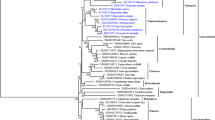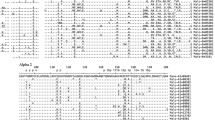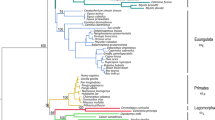Abstract
In order to identify the Toll-like receptor 5 (TLR5) as a putative candidate disease-resistance gene in Tibetan macaque (Macaca thibetana), two pairs of primers were designed based on the TLR5 gene sequence of rhesus macaque (Macaca mulatta, NM_001130429). The primers were used to amplify the TLR5 gene from Tibetan macaque, by the polymerase chain reaction (PCR). The compiled sequences were analyzed by bioinformatics. The DNA sequencing and additional combined results showed that the Tibetan macaque TLR5 gene is about 2825 bp and contains an open reading frame of 2577 bp encoding for 858 amino acids. Homology analysis of TLR5 in both species showed that the amino acid and nucleotide identity is about 99.7% and 99.8% and their transmembrane and intracellular domains appeared more conservative than the extracellular domains of proteins. However, re-examining the entire Tibetan macaque TLR5 coding sequence we found that a purifying selection was also acting on the TLR5 gene region encoding for its intracellular domain of the protein. Even though the selection tests indicated that the TLR5 gene experienced a strong purifying selection in the process of evolution, most likely because its potential role in the primate adaptive immune defense, the Tibetan macaque still has the highest relationship with the rhesus macaque.
Similar content being viewed by others
References
Asahina Y, Yoshioka N, Kano R, Moritomo T and Hasegawa A (2003) Full-length cDNA cloning of Toll-like receptor 4 in dogs and cats. Vet. Immunol. Immunopathol. 96: 159–167.
Alder MN, Rogozin L B, Glazko GV, Cooper MD and Pancer Z (2005) Diversity and Function of Adaptive Immune Receptors in a Jawless Vertebrate. Science 310: 1970–1973.
Akira S, Uematsu S and Takeuchi O (2006) Pathogen Recognition and Innate Immunity. Cell 124: 783–801.
Brightbill H. D. and Modlin R. L. (2000) Toll-like receptors: molecular mechanisms of the mammalian immune response. Immunology 101: 1–10.
Bonnet E and Peer Y (2002) zt: a software tool for simple and partial Mantel tests. J. Stat. Software 7: 1–12.
Goodman M, Porter CA, Czelusniak J, Page SL, Schneider H, Shoshani J, Gunnell G and Groves CP (1998) Toward a Phylogenetic classification of primates based on DNA evidence complemented by fossil evidence. Mol. Phyl. Evol. 9: 585–598.
Gómez-Gómez L and Boller T (2000) FLS2: an LRR receptor-like kinase involved in the perception of the bacterial elicitor agellin in Arabidopsis. Mol. Cell 5: 1003–1011.
Gómez-Gómez L and Boller T (2002) Flagellin perception: a paradigm for innate immunity. Trends Plant Sci. 7: 251–256.
Gay NJ and Gangloff M (2007) Structure and function of Toll receptors and their ligands. Annu. Rev. Biochem. 76: 141–165.
Hayashi F, Smith KD, Ozinsky A, Hawn TR, Yi EC, Goodlett DR, Eng JK, Akira S, Underhill DM and Aderem A (2001) The innate immune response to bacterial flagellin is mediated by Toll-like receptor 5. Nature 410: 1099–1103.
Hawn TR, Verbon A, Lettinga KD, Zhao LP, Li SS, Laws RJ, Skerrett SJ, Beutler B, Schroeder L, Nachman A, Ozinsky A, Smith KD and Aderem A (2003) A Common Dominant TLR5 Stop Codon Polymorphism Abolishes Flagellin Signaling and Is Associated with Susceptibility to Legionnaires’ Disease. J. Exp. Med. 198: 1563–1572.
Jiang XL, Wang YX and Wang QS (1996) The classification and distribution of Macaca thibetana. Zoo. Res. 17: 361–369.
Kobe B and Deisenhofer J (1994) The leucine-rich repeat: a versatile binding motif. Trends Biochem. Sci. 19: 415–421.
Kobe B and Kajava A. V (2001) The leucine-rich repeat as a protein recognition motif. Curr Opin in Struct. Biol. 11: 725–732.
Kawai T and Akira S (2010) The role of pattern-recognition receptors in innate immunity: update on Toll-like receptors. Nat Immunol. 11:373–384
Li WH (1993) Unbiased estimation of the rates of synonymous and nonsynonymous substitution. J. Mol. Evol. 36:96–99.
Litman GW, Dishaw LJ, Cannon JP, Haire RN and Rast JP (2007) Alternative Mechanisms of Immune Receptor Diversity. Curr Opin Immunol. 19: 526–534.
Li DD, Wang TT, Song XB, Qucuo M, Yang B, Zhang JL, Wang J, Ying BW, Tao CM and Wang LL (2011) Genetic study of two single nucleotide polymorphisms within corresponding microRNAs and susceptibility to tuberculosis in a Chinese Tibetan and Han population. Human Immunol. 72: 598–602.
Matsushima N, Tanaka T, Enkhbayar P, Mikami T, Taga M, Yamada K and Kuroki Y (2007) Comparative sequence analysis of leucine-rich repeats (LRRs) within vertebrate toll-like receptors. BMC Genomics 8: 124.
Nakajima T, Ohtani H, Satta Y, Uno Y, Akari H, Ishida T and Kimura A (2008) Natural selection in the TLR-related genes in the course of primate evolution. Immunogenetics 60: 727–35.
Pamilo P and Bianchi (1993) NO: Evolution of the Zfx and Zfy genes: rates and interdependence between the genes. Mol. Biol. Evol. 10: 271–281.
Roach JC, Glusman G, Rowen L, Kaur A, Purcell MK, Smith KD, Hood LE and Aderem A (2005) The evolution of vertebrate Toll-like receptors. Proc. Natl. Acad. Sci. USA 102: 9577–9582.
Takeda K and Akira S (2005) Toll-like receptors in innate immunity. International Immunology 17: 1–14.
Tamura K, Peterson D, Peterson N, Stecher G, Nei M, Kumar S (2011) MEGA5: molecular evolutionary genetics analysis using maximum likelihood, evolutionary distance, and maximum parsimony methods. Mol. Biol. Evol. 28: 2731–2739.
Thomas PD, Campbell MJ, Kejariwal A, Mi H, Karlak B, Daverman R, Diemer K, Muruganujan A, Narechania A (2003) PANTHER: A library of protein families and subfamilies indexed by function. Genome Res. 13: 2129–2141.
Werling D, Jann OC, Offord V, Glass EJ, Coffey TJ (2009) Variation matters: TLR structure and species-specific recognition. Trends Immunol. 30: 124–130.
Wlasiuk G, Khan S, Switzer W.M and Nachman M.W. (2009) A history of recurrent positive selection at the toll-like receptor 5 in primates. Mol. Biol. Evol. 26: 937–949.
Watts C, West M. A. and Zaru R (2010) TLR signaling regulated antigen presentation in dendritic cells. Curr. Opin. Immunol. 22: 124–130
Author information
Authors and Affiliations
Corresponding author
Additional information
Y. Huang and Y.-F. Yao contributed equally to this work.
Rights and permissions
About this article
Cite this article
Huang, Y., Yao, YF., Li, Y. et al. Identification and molecular evolutionary analysis of TLR5 gene from the Tibetan macaque (Macaca thibetana). Genes Genom 34, 423–428 (2012). https://doi.org/10.1007/s13258-011-0226-7
Received:
Accepted:
Published:
Issue Date:
DOI: https://doi.org/10.1007/s13258-011-0226-7




